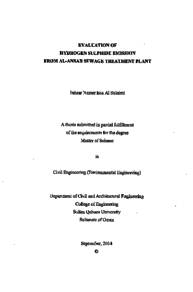Document
Evaluation of hydrogen sulphide emission from Al-Ansab sewage treatment plant
Publisher
Sultan Qaboos University
Gregorian
2014
Language
English
Subject
English abstract
Odor is defined as the perception of smell or as a sensation resulting from the reception of stimulus by the olfactory sensory system, Odors emitted from wastewater treatment plants (WTPs) are becoming a significant source of environmental annoyance. Odor related complaints from communities surrounding WTPs have been constantly increasing during the last decade. Most commonly reported odor-producing compounds are hydrogen sulfide (H2S) and ammonia (NH3). The purpose of this research study is to evaluate H2S emission from Al-Ansab sewage treatment plant. The emphasis of the study is to compare the H2S concentrations discharged from chemical wet scrubber to the plant standard specifications. In addition, it aims to determine the H2S emission dispersion from the main odor sources. There are a number of odor sources within Al-Ansab sewage treatment plant that together or independently result in the presence of significant odor. The concentrations of H2S were measured by Multi-gas Detector from different locations. The efficiency of the chemical wet scrubber was evaluated. Moreover, Gaussian dispersion equation was used to estimate the concentrations of H2S downwind direction from the main two odor sources in the plant. The dispersion of H2S emission was analyzed under two different weather conditions. The results showed that the efficiency of the chemical wet scrubber was about 90%. However, the concentration of H2S at the outlet of the scrubber was not complying with the specified value (1 ppm) in many times. The possible causes and observations of the resulted chemical wet scrubber efficiency were analyzed and discussed. The dispersion findings demonstrated that the required limit of the concentration of H2S of 1 ppm was found after 50 m from both sources under the stable weather conditions. Whereas, theses distances were found at 30 m from the tanker discharge facility and 8 m from the chemical wet scrubber outlet stack location under the unstable weather conditions. It is concluded that the plant is not complying well with the required specifications of H2S. Hence, some recommendations were suggested to reduce the odor problem at Al Ansab plant and to improve the efficiency of the chemical wet scrubber
Description
Thesis
Member of
Resource URL
Arabic abstract
أصبحت الروائح المنبعثة من محطات معالجة مياه الصرف الصحي مصدرا هاما من مصادر الإنزعاج البيئي وبالتالي فإن الشكاوى من المجتمعات المحيطة بمحطات الصرف الصحي المتعلقة بالروائح كانت تتزايد باستمرار خلال العقد الماضي. أثبتت الدراسات العليمة أن المركبات المنتجة للرائحة الأكثر شيوعا هي كبريتيد الهيدروجين (H2S) والأمونيا (NH3).
تهدف هذه الدراسة إلى تقييم إنبعاثات كبريتيد الهيدروجين من محطة الأنصب لمعالجة مياه الصرف الصحي. كما تركز الدراسة على مقارنة تركيزات كبريتيد الهيدروجين بعد تفريغها من الغسيل الرطب الكيميائي مع المواصفات القياسية للمحطة. وبالإضافة إلى ذلك، فإن الدراسة تهدف إلى تحديد انتشار إنبعاثات كبريتيد الهيدروجين من المصادر الرئيسية للروائح في المحطة هناك عدد من المصادر المسببه للروائح داخل محطة الأنصب التي تسهم معا أو بشكل مستقل في وجود رائحة كبيرة. ولذلك تم قياس تركيزات غاز كبريتيد الهيدروجين بواسطة كاشف غازات متعدده في مواقع مختلفة. كما أنه تم تقييم كفاءة وحدة الغسيل الرطب الكيميائي بالمحطة لمعالجة الروائح. وعلاوة على ذلك، تم استخدام معادلة جاوس الإنتشار الملوثات في الهواء لتقدير تركيزات كبريتيد الهيدروجين في اتجاه الريح من مصدرين رئيسين في المحطة. إضافة إلى ذلك، تم تحليل انتشار انبعاثات كبريتيد الهيدروجين تحت حالتي طقس مختلفة. أظهرت نتائج الدراسة أن كفاءة الغسيل الرطب الكيميائي تصل إلى 90%. ولكن لوحظ أن تراكيز كبريتيد الهيدروجين الناتجة من وحدة الغسيل الرطب الكيميائي يتجاوز التركيز القياسي (1 جزء في المليون) في مرات عدة. تم تحليل ومناقشة الأسباب والإحتمالات التي أدت إلى هذه الكفاءة. أظهرت النتائج أن انتشار الحد المطلوب من تركيز كبريتيد الهيدروجين من 1 جزء في المليون عثر بعد 50 متر من كل من المصدرين تحت الظروف الجوية المستقرة. في حين، عثر على التركيز القياسي على بعد مسافات 30 متر من مرفق التصريف و 8 متر من وحدة الغسيل الرطب الكيميائي تحت الظروف الجوية الغير مستقرة. ويستنتج من ذلك أن المصنع لا يمتثل مع المواصفات المطلوبة من تركيز كبريتيد الهيدروجين، وبالتالي، اقترحت الدراسة بعض التوصيات لتحسين كفاءة الغسيل الرطب الكيميائي ولتقليل مشكلة الروائح في محطة الأنصب
تهدف هذه الدراسة إلى تقييم إنبعاثات كبريتيد الهيدروجين من محطة الأنصب لمعالجة مياه الصرف الصحي. كما تركز الدراسة على مقارنة تركيزات كبريتيد الهيدروجين بعد تفريغها من الغسيل الرطب الكيميائي مع المواصفات القياسية للمحطة. وبالإضافة إلى ذلك، فإن الدراسة تهدف إلى تحديد انتشار إنبعاثات كبريتيد الهيدروجين من المصادر الرئيسية للروائح في المحطة هناك عدد من المصادر المسببه للروائح داخل محطة الأنصب التي تسهم معا أو بشكل مستقل في وجود رائحة كبيرة. ولذلك تم قياس تركيزات غاز كبريتيد الهيدروجين بواسطة كاشف غازات متعدده في مواقع مختلفة. كما أنه تم تقييم كفاءة وحدة الغسيل الرطب الكيميائي بالمحطة لمعالجة الروائح. وعلاوة على ذلك، تم استخدام معادلة جاوس الإنتشار الملوثات في الهواء لتقدير تركيزات كبريتيد الهيدروجين في اتجاه الريح من مصدرين رئيسين في المحطة. إضافة إلى ذلك، تم تحليل انتشار انبعاثات كبريتيد الهيدروجين تحت حالتي طقس مختلفة. أظهرت نتائج الدراسة أن كفاءة الغسيل الرطب الكيميائي تصل إلى 90%. ولكن لوحظ أن تراكيز كبريتيد الهيدروجين الناتجة من وحدة الغسيل الرطب الكيميائي يتجاوز التركيز القياسي (1 جزء في المليون) في مرات عدة. تم تحليل ومناقشة الأسباب والإحتمالات التي أدت إلى هذه الكفاءة. أظهرت النتائج أن انتشار الحد المطلوب من تركيز كبريتيد الهيدروجين من 1 جزء في المليون عثر بعد 50 متر من كل من المصدرين تحت الظروف الجوية المستقرة. في حين، عثر على التركيز القياسي على بعد مسافات 30 متر من مرفق التصريف و 8 متر من وحدة الغسيل الرطب الكيميائي تحت الظروف الجوية الغير مستقرة. ويستنتج من ذلك أن المصنع لا يمتثل مع المواصفات المطلوبة من تركيز كبريتيد الهيدروجين، وبالتالي، اقترحت الدراسة بعض التوصيات لتحسين كفاءة الغسيل الرطب الكيميائي ولتقليل مشكلة الروائح في محطة الأنصب
Category
Theses and Dissertations


